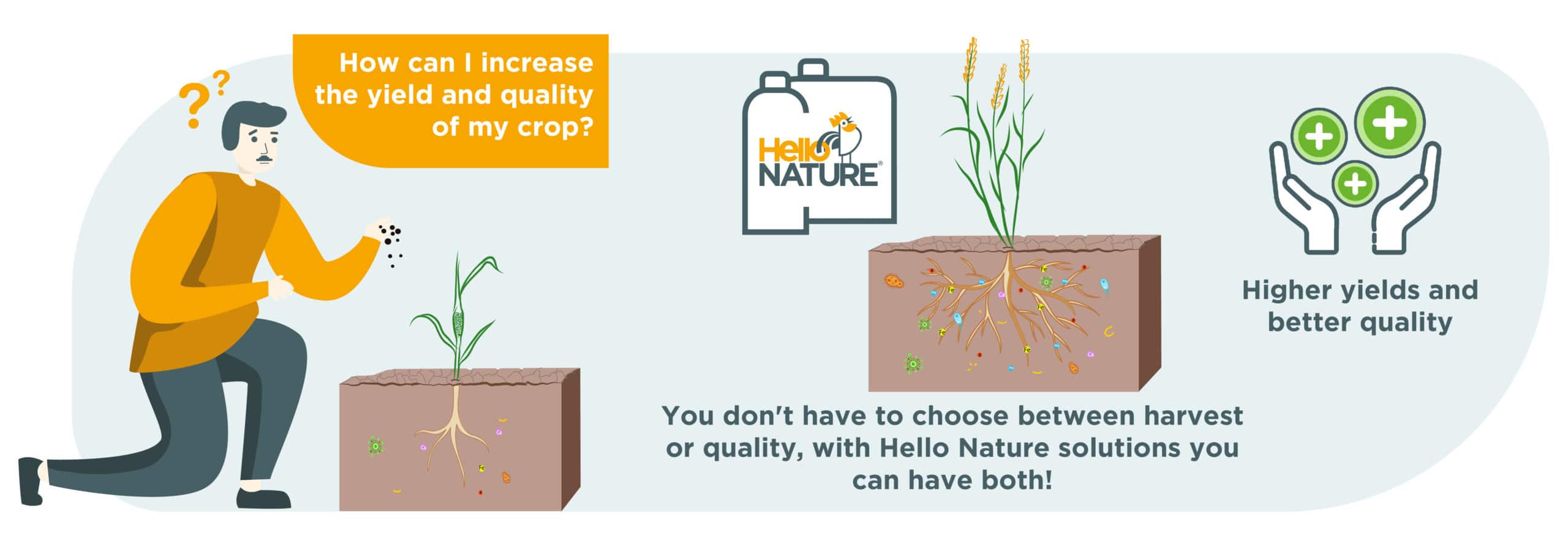Agriculture is a huge part of the climate solution, it has and will have a central role in building a more sustainable future, facing different challenges:
- Satisfying, with less inputs and less soil available, the requests of the ever-growing world population, Food and Agriculture Organization (FAO) estimates by 2050 we will need to produce 60 per cent more food to feed a world population of 9.1 billion.
- Growing crops in sub-optimal conditions continuously facing extreme weather like drought, heat, flooding, and frost.
Agricultural sector has no choice but to embark on a greener revolution which means increase crop productivity and quality applying sustainable practices and reducing environmental footprint.
Crop yield is a standard measurement of the amount of agricultural production harvested per unit of land area. It is probably the most important measure of any farmer's performance and the farmer's income also depends on it.
The yield per hectare, however, is no less important than the quality of the production itself. In fact, a high yield but of poor quality does not allow the farmer to reach his profitability objectives and significantly increase the difficulties in marketing. On the contrary, improving the quality of the harvest, as well as obtaining productions with superior qualitative and organoleptic characteristics corresponds to a greater market value of agricultural production and therefore greater profitability. The search for quality characteristics mainly depends on the type of crop and the destination of the production, such as human consumption or animal feed.
Therefore, yield and quality are both fundamental to guarantee the profitability of the farmer. Given this, no wonder that most farmers find themselves in a constant quest called "How to increase yield and crop quality?".
Let’s see what are the main and the most efficient Hello Nature solutions that can help farmers achieve better yields and quality on their fields.
HELLO NATURE SOLUTIONS TO IMPROVE YIELD AND QUALITY
Biological seed treatment
Agricultural productivity depends on the quality of seeds with which farmers sow their fields. Our Biological seed treatment based on microorganisms (Mycorrhizae, Trichoderma, rhizosphere bacteria) is the best solution to start your cultivation and safeguard the quality of the seeds for the benefit of productivity and quality of the harvest. It is the sustainable basis of the entire crop cycle, allows for better germination, increases the resistance of plants to abiotic stresses, the availability of nutrients and the root development. Our seed treatments solutions have polyvalent and high persistence action that stimulate and support the development of the plant throughout the entire crop cycle. Our seed treatment biostimulants exceed the limit of traditional chemical products used for seed treatment: traditional chemical agents do not improve the biological activity around the roots which are vulnerable at all stages of the crop cycle. Our biological seed treatment based on microorganisms guarantee a good productive and qualitative performance in all soil and climate conditions. Without the use of tanned seeds, you could have crop losses of even more than 20% and possible cost increases of up to 200%.
Fertilizers
Yield and the quality of products from crops are strongly linked to the supply of nutrients through fertilizers product. Plants need the right combination of nutrients to live, grow and reproduce. Their use should be balanced and prudent. In fact, using too much fertilizers can negatively affect the soil quality and, therefore, the agricultural productivity. The objective of fertilizer application is to commensurate the contributions of nutritional elements to the real needs of the crop without incurring over-dosages which, in addition to constituting an unnecessary cost for the farmer, could negatively affect soil quality and cause environmental pollution, or in under-dosages which would lead to reduced and sometimes poor quality productions and, in the long run, could decrease the overall fertility of the soil.
The best solution is to use fertilizers properly following an accurate fertilization plan defined according to:
- The crop and the dynamics of absorption;
- The quantity and quality of the production expected to be obtained;
- The physical-mechanical and chemical characteristics of the soil;
- The climatic conditions of the cultivation area;
- Crops in rotation on the plot to be fertilized.
Our fertilizers are suitable for many different types of crops and in combination with our plant biostimulants and beneficial microorganisms allow to obtain the maximum yield potential and quality.
Biostimulants
We can sustainably increase crop production and quality by using biostimulants, which are a critical element of sustainable agriculture because of their ability to improve soil health and increase nutrient use efficiency.
Examples of physiological functions that biostimulants can affect include such things as increases in root growth and biomass, increased uptake and translocation of nutrients, activation of hormone signaling pathways and gene expression, protection of photosynthetic activity during stress, and even improving a plants rhizosphere which can provide a better environment for symbiotic relationships with beneficial microbials in the soil.
Stimulation of these physiological functions then result in actual physical changes in plants, such as a better nutritional composition of plants, improvements in nutrient use competence, improved water use capability, enhanced resistance to and recovery from abiotic stress - such as drought and salinity, and higher chlorophyll concentrations.
The use of Biostimulants in fruit, vegetable, and industrial crops can have a positive effect both on extrinsic qualitative traits such as product uniformity, fruit consistency and size, and on intrinsic traits. For example, it has been found that the application of Biostimulants can:
- Increase the content of mineral elements (biofortification effect) with positive effects on human nutrition.
- Increase the content of compounds with nutraceutical action (e.g., ascorbic acid, carotenoids, phenols) through stimulation of plant secondary metabolism.,
- Increase the accumulation of carbohydrates or organic acids that affect the nutritional or organoleptic quality of the product through having a positive effect on the primary metabolism of the plant.
- Reduce the content of undesirable compounds and anti-nutritional factors such as nitrates in leafy vegetables through having a positive effect on the enzymatic process of nitrate assimilation.
|








